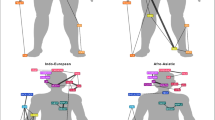Abstract
This study analyzes and compares the linguistic expressions of three sets of body-part terms extracted from the largest, balanced and widely-used Mandarin Chinese corpus, and aims to find their actual usage patterns in the real world context of Mandarin Chinese. It is found that PERSON and EMOTION are the most prevalent metonymic meaning in the six body part terms. As for the metonymic and metaphorical meanings in the six body-part terms and their corresponding word component structures, it is found that when the body-part terms denote PERSON, the most dominant word component structure is [NN]\(_{\mathrm N}\); when they denote EMOTION, [NN]\(_{\mathrm N}\) and [VN]\(_{\mathrm V}\) are the most dominant structures. In addition, the [NN]\(_{\mathrm N}\) structure shows the highest frequency of occurrences in all the six body part terms when they are used metaphorically.
Access this chapter
Tax calculation will be finalised at checkout
Purchases are for personal use only
Similar content being viewed by others
References
Cameron, L., Deignan, A.: The emergence of metaphor in discourse. Appl. Linguist. 27(4), 671–690 (2006)
Deignan, A.: The grammar of linguistic metaphors. Trends Linguist. Stud. Monogr. 171, 106 (2006)
Huang, C., Chen, K., Chang, L., Hsu, H.: An introduction to academia Sinica balanced Corpus. In: Proceedings of ROCLING VIII, pp. 81–99 (1995). (in Chinese)
Hung, Y.Y., Gong, S.P.: A cross-linguistic approach to body part metonymy in English and Chinese. In: Effects of an On-line Syntactic Analysis Strategy Instruction on University Students’ Reading Comprehension of English Science Texts, vol. 16, p. 146 (2011)
Lakoff, G., Johnson, M.: Metaphors We Live By. University of Chicago Press, Chicago (1980)
Lu, Z.: Word Formation in Chinese. Scientific, Beijing (1964)
Packard, J.L.: The Morphology of Chinese: A Linguistic and Cognitive Approach. Cambridge University Press, Cambridge (2000)
Qin, X.: The conceptual metaphors of “eye” - a comparative study based on the corpus between English and Chinese. J. Foreign Lang. 31(5), 37–43 (2008)
Stefanowitsch, A., Gries, S.T. (eds.): Corpus-Based Approaches to Metaphor and Metonymy, vol. 171. Walter de Gruyter, Berlin (2007)
Tsai, L.C.: The Metaphor of Body Parts in Chinese. Unpublished Master of Arts Thesis, National Tsing-Hua University, Taiwan (1994)
Wen, X., Wu, S.Q.: A study on the cognitive features of the metaphoric expressions involving the English and Chinese FACE. J. Southwest Univ. 6, 28 (2007). (Social Sciences Edition)
Xie, H.Z.: Comparative study on metaphorical meaning of vocabulary with the denotation of “face” between Chinese and English. Unpublished Master of Arts Thesis, Central China University, China (2011)
Yu, N.: Metaphor from body and culture. In: The Cambridge Handbook of Metaphor and Thought, pp. 247–261 (2008)
Yu, N.: Speech organs and linguistic activity/function in Chinese (a revised and expanded version of a 2009 book chapter). In: Maalej, Z., Ning, Y. (eds.) Embodiment via Body Parts: Studies from Various Languages (Human Cognitive Processing series, 31), pp. 117–148. John Benjamins, Amsterdam (2011)
Zhai, L.F.: The interaction of metaphor and metonymy in the Chinese expressions of body-part terms Yan and Mu. Canadian Soc. Sci. 4(1), 57–62 (2009)
Zhao, X.D.: A cognitive study on meaning transference of body-part terms. Unpublished Doctoral Dissertation, Fudan University, China (2010)
Author information
Authors and Affiliations
Corresponding author
Editor information
Editors and Affiliations
Rights and permissions
Copyright information
© 2017 Springer International Publishing AG
About this paper
Cite this paper
Hsu, HL., Lai, Hl., Liu, JS. (2017). Meaning Extensions, Word Component Structures and Their Distribution: Linguistic Usages Containing Body-Part Terms Liǎn/Miàn, Yǎn/Mù and Zuǐ/Kǒu in Taiwan Mandarin. In: Ekštein, K., Matoušek, V. (eds) Text, Speech, and Dialogue. TSD 2017. Lecture Notes in Computer Science(), vol 10415. Springer, Cham. https://doi.org/10.1007/978-3-319-64206-2_38
Download citation
DOI: https://doi.org/10.1007/978-3-319-64206-2_38
Published:
Publisher Name: Springer, Cham
Print ISBN: 978-3-319-64205-5
Online ISBN: 978-3-319-64206-2
eBook Packages: Computer ScienceComputer Science (R0)




